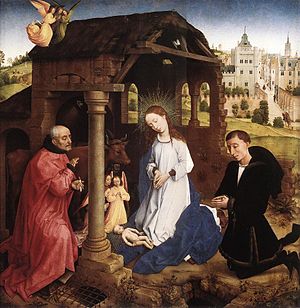
A donor portrait or votive portrait is a portrait in a larger painting or other work showing the person who commissioned and paid for the image, or a member of his, or (much more rarely) her, family. Donor portrait usually refers to the portrait or portraits of donors alone, as a section of a larger work, whereas votive portrait may often refer to a whole work of art intended as an ex-voto, including for example a Madonna, especially if the donor is very prominent. The terms are not used very consistently by art historians, as Angela Marisol Roberts points out,[1] and may also be used for smaller religious subjects that were probably made to be retained by the commissioner rather than donated to a church.
Donor portraits are very common in religious works of art, especially paintings, of the Middle Ages and Renaissance, the donor usually shown kneeling to one side, in the foreground of the image. Often, even late into the Renaissance, the donor portraits, especially when of a whole family, will be at a much smaller scale than the principal figures, in defiance of linear perspective. By the mid-15th century donors began to be shown integrated into the main scene, as bystanders and even participants.
- ^ Roberts, pp. 1–3, 22